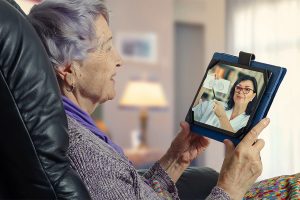Technology has become an integral part of our daily lives. From YouTube videos to online forums, live-streams to grocery delivery, we have been transported into a new digital age. While younger people who have grown up in this age may have little trouble, it can be difficult to navigate for those not accustomed to technology.
However, this difficulty is outweighed by the many rewards of using tech. For older adults in particular, investing the time and energy required to become comfortable with technology can have a huge positive impact, from your social life to personal growth. Many activities traditionally done in person have expanded online, one of which being telehealthcare. Though getting started with online healthcare can seem daunting, with the right knowledge and toolset this can become a valuable resource for anyone, no matter their age.
Bridging the digital divide
Often, it can feel like there is an unbridgeable gap or divide between those who “can” and “cannot” use technology. This is especially the case for older adults, where factors such as affordability, lack of training, and accessibility issues can prevent you from engaging with modern technology. Despite this, there are several strategies that can be implemented to help you develop, hone, or perfect your technological skills.
The factors at play
The first step to achieving technological prowess is understanding what factors are holding you back. For older adults, a common factor is simply a lack of access to technology. You may not have your own device, or have an older model that does not support many features. You may also be dealing with age-related issues including hearing loss, decreased vision, cognitive decline, or the loss of motor skills. All of these are natural parts of growing older, but can definitely become hindrances with newer technologies, which are often designed with a younger audience in mind.
The impacts of this divide
Also important to understand are the impacts that this digital divide can have. Specifically for elders, feeling disconnected from technology can lead you to feel disconnected from friends and family, as well as society as a whole. Watching the younger generation be tuned in to their phones all day can be quite isolating when you don’t know how to join in, and can lead to a loss of connection with family members.
Alongside this, the digital divide can limit your access to doctors and healthcare information. An increasing number of scientific papers and journals are only posted online, meaning that the internet is becoming essential in staying up to date on the latest developments in healthcare. In addition, if you are living in a remote area or have mobility issues, getting to doctor’s appointments can be made significantly easier with online options—a lack of access to these services can cause health issues to go unresolved.
Benefits of bridging the gap
On the positive side, these previously mentioned issues can be turned into benefits when you’ve learned to use technology. By bridging the digital divide, you will be able to immensely increase your social circle, feel better connected to family, and improve access to helpful healthcare services—all while improving your brain’s health.
Social life
Using the internet is a fantastic way to connect with new people. With just a simple Google search, you can find clubs, events, and social groups for just about every topic or activity; there truly is something for everyone. Platforms such as Facebook and Meetup often have an assortment of events listed, with the ability to search by area, activity, and skill level. As we age, our social circles tend to grow smaller—learning to use technology can allow you to open yourself to experiences that you wouldn’t have otherwise.
Learning to use technology can also be a great bonding opportunity for you and your family. It can feel difficult to relate to your younger relatives, as times have changed so dramatically in the past few decades. Having common experiences of struggling with technology or exchanging tips can really bring your family together again. Some hobbies, such as playing chess for example, can be moved into the digital world; you might try organizing times to play against each other online or over a video call as a way to interact with family more often.
Healthcare
Having access to the internet also opens up a whole world of possibilities in terms of healthcare. Options to attend doctor’s appointments virtually can also lower your risks of exposure to hospital-acquired infections, which can be particularly detrimental to those who are older. In a review by the National Library of Medicine, it was noted that the immune system becomes dramatically weaker after the sixth decade of life. While a variety of measures are taken to minimize viral spread, the risks of catching something are still quite high when visiting a doctor in person, especially for those with weaker immune systems. If you are an older adult, consulting a doctor virtually can help to negate your risks of exposure.
Cognition
Learning new skills has been proven to improve your brain’s health. According to the Central Connecticut State University, learning new things has been shown to increase myelin growth on nerve axons. Myelin acts as an insulator for nerves, and so having more myelin allows our neurons to improve the speed of their signaling. Interestingly, this is especially true for older adults, so there is no reason to think that you are “too old” to learn new things—it’s actually quite the opposite! Myelin growth is also particularly effective when new experiences are repeated, meaning that the action of practicing technology use is a fantastic thing for your brain’s continued development.
Starting your technological journey
Now that you know the benefits of learning to use technology, chances are that you would like to start. However, it’s also likely that you’re unsure of where to begin. Using the following tips can help to get you on the right track!
Talk to family
As mentioned earlier, getting your family involved when learning technology can be a fantastic way to bond and connect with relatives, especially those who are younger. You might consider setting up weekly or biweekly visits to tackle tech problems or find new pages to save and bookmark—which is an incredibly useful feature—as a way to catch up and reconnect.
Having your family present when starting out can also be helpful for adjusting settings to suit your needs. For those with accessibility needs, such as vision or hearing loss, there are a number of settings which you might want to check out. These include things like font size, contrast, and caret navigation, and can make your device easier to use. If you have a touch screen device, using a stylus may also help as age can cause dry fingertips, which are harder for the device to recognize.
Try online courses
Whatever the reason, some of us do not have family who we can rely on for help. If that is the case (or if you simply want to supplement your learning) there are courses both online and in person that are dedicated to helping older adults with tech. These can also be great ways to meet and connect with new people or, if you are content with the friends you currently have, can be done with people you already know.
Practice regularly, and be patient
Just as any other skill, becoming comfortable with using technology requires patience, time, and practice. Try setting aside time each day to practice, even if it’s just for 15 minutes or so—the key here is consistency, not duration. Practice also does not have to be painful either! Playing a game like solitaire, chess, scrabble, or doing puzzles online can be a great way to get practice in while still having fun.
Telehealth: what is it?
Once you are comfortable with using tech, you will be able to reap the rewards! As mentioned before, there are many great uses for tech; one of the most useful applications of technology for older adults is telehealth.
Telehealth is a broad term which encompasses any healthcare that is provided remotely, using technology. There are several types of telehealth, which can be organized into three main categories: synchronous, asynchronous, and remote monitoring.
Types of telehealth
Synchronous telehealth involves live communication between the patient and the healthcare provider. This can range from audio-visual video calling to text-only messaging, based on what the patient prefers, and what the situation may be—for example, synchronous video calls are used to assess acute (sudden) conditions, while synchronous text messaging may be used to treat chronic (long term) conditions and provide resources. Synchronous telehealth also includes scheduled appointments, such as online therapy sessions.
While synchronous telehealth happens in real time, asynchronous telehealth does not. As a result, according to the US government’s Telehealth Guide, asynchronous telehealth is “often used for patient intake or follow-up care” rather than immediate treatment. These services can be used to send and store vital information, such as photos, laboratory results, and past medical histories. As you grow older, it is common to accumulate a long history of past medical issues or procedures; being able to input these details on your own time without worrying about appointment length can be very beneficial.
The third main type of telehealth is remote monitoring, or the use of digital monitoring devices to keep track of a patient’s health. This is a subtype under the asynchronous telehealth umbrella and does not involve live patient-provider communication. Rather, the data is collected and transmitted to the provider who can then look over the results with or without the patient. These remote patient monitoring devices can be especially helpful for older adults, as they can help to keep tabs on chronic conditions like high blood pressure, kidney diseases, heart issues, and other conditions which become more common as you age.
Applications of Telehealth for Older Adults
While telehealth is beneficial for just about anyone, it can be an especially helpful tool for older adults. As the World Health Organization explains, “aging results from the impact of the accumulation of a wide variety of molecular and cellular damage over time (leading) to a gradual decrease in physical and mental capacity (and) a growing risk of disease”. These elevated risks of disease directly translate to an increase in doctors visits, appointments, and procedures—which then lead to elevated risks of exposure to hospital germs, general fatigue from commutes to the hospital, and other unpleasant effects.
While telehealth cannot immediately alleviate chronic pain symptoms or cure diseases, it can lower the stress of travelling to and from your appointments. Being able to contact your doctor to ask questions can also put your mind at ease quickly.
Utilizing telehealth: what to expect
While telehealth is designed to be as transparent and easy to use as possible, it is natural to have reservations about starting something new. Below, we have outlined what to expect before, during, and after a routine telehealth appointment.
Before your appointment
Not all healthcare can be administered virtually. If you have not heard about telehealth already, try asking your doctor whether telehealth would be an option for you. If it is, your next step is to begin coordinating with them to set up an appointment; this can be done during an in-person appointment or from your own home.
If this is your first time setting up an appointment from home, consider having a caregiver or family member there to guide you through the process. It may also be helpful to have them present for the first few sessions, until you are comfortable with setting them up on your own. After you have joined successfully, they could stay in the room or leave if you wish. As with any doctor’s appointment, you will likely need to discuss sensitive topics, such as depression, anxiety, or physical ailments; having them leave the room may make this easier. On the other hand, having a trusted family member, friend, or caregiver may make this easier. Take some time to figure out what you would like to happen, and be sure to communicate this with everyone involved before the appointment starts.
Certain changes can also be made to suit your accessibility needs. For those who have hearing loss, some programs have a “speech-to-text” option which can provide live captioning during audio calls. If you have visual impairments, audio-only calls will work well, and should you want to look at something on the screen, changing the display settings to “high contrast mode” can help to make things more distinguishable.
During your appointment
Appointments can range from 10 minutes to an hour long, depending on your needs—a quick check-up will naturally be shorter than a detailed therapy session. On average, sessions are likely to be around 15 minutes, but this can usually be adjusted to fit your lifestyle.
The appointment itself should be very similar to an in-person visit to a doctor. Your provider will assess any complaints you may have, discuss treatment options, and create a treatment plan for you. Sometimes, they may request you come in for testing or lab work, or request that you send them a picture of a particular area. For example, if you have a rash, they may ask for a better look by using a close-up photo.
After your appointment
After your appointment, you should receive a post-appointment message of some kind from your healthcare provider. This can be via email, text, or phone call, and will usually include a summary of the appointment, resources, and any next steps to follow. For those with sensory impairments, you should be able to request that resources be sent in an accessible format—print, email, video, etc—to ensure that you are able to look through them without issues.
A final note on internet safety
While the internet is full of fantastic resources, services, and people, there are also many malicious scams and fraudulent services that aim to gain access to personal and financial information. Unfortunately, many of these will directly target elderly people, as you are less used to technology and more vulnerable to manipulation.
Common tactics include phone scams, where scammers will contact you and pretend to be from a trusted source, like a bank, and ask for personal details such as account information or passwords. This can also happen by email or text messages. If you are ever unsure of the legitimacy of an email—especially if it contains links, which can be used to infect your computer with malware—contact your family or caregivers to have them double check. It’s better to be safe than sorry!
Above all, remember that practice makes progress—not perfection. If you suspect that you have been scammed, or are having issues with anything else, you should never feel ashamed. In fact, asking for help might just be the key to your future technological success.









